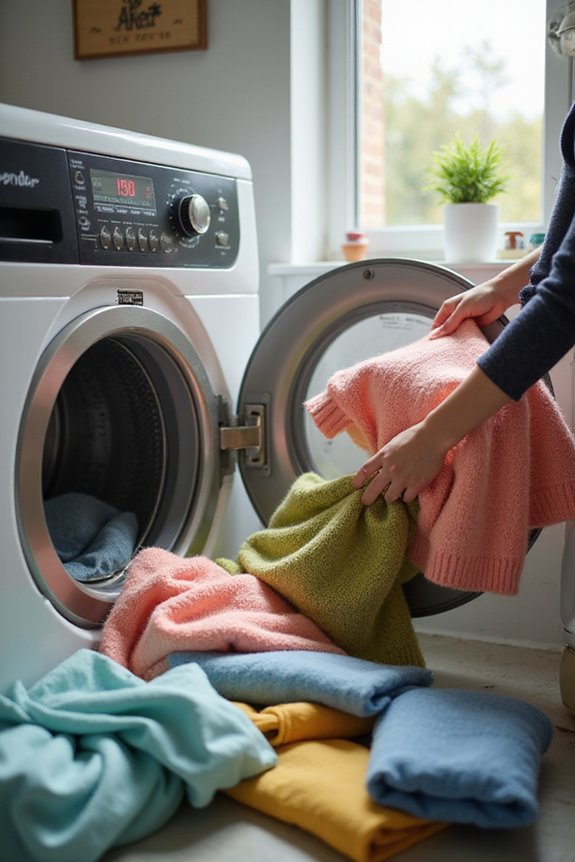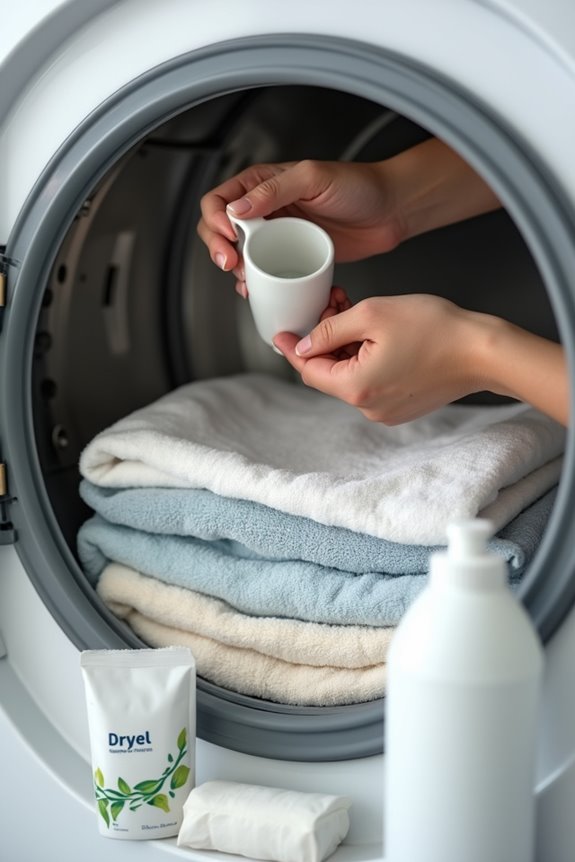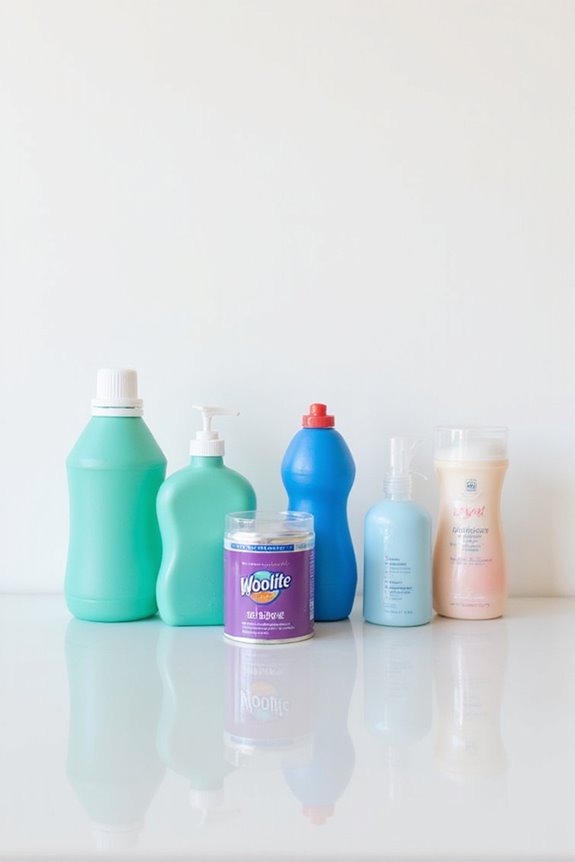When we tumble dry clothes, it’s smart to sort by fabric type and weight first. We want to avoid tangles, so let’s separate light and heavy items. Filling the dryer about 3/4 full helps with airflow, and using the right heat setting is key: high for towels, medium for everyday wear, and low for delicates. Don’t forget to clean the lint filter after each use! Stick with these tips, and we’ll keep our clothes fresh and happy. There’s more handy advice ahead!
Key Takeaways
- Sort clothes by fabric type and weight to enhance drying efficiency and prevent damage to delicate items.
- Fill the dryer drum to about 3/4 full to maintain airflow and ensure even drying.
- Select appropriate heat settings based on fabric care labels, using high heat for heavy items and low heat for delicate fabrics.
- Clean the lint filter after each cycle and inspect the vent annually to maintain dryer performance and safety.
- Consider using dryer balls for improved drying efficiency and to reduce wrinkles in your clothes.
Sorting Clothes by Fabric Type and Weight
When it comes to drying our clothes, sorting them by fabric type and weight is a game-changer. We’ve all learned that checking garment care labels is essential; they tell us what fabric we’re dealing with. Using fabric identification methods, we can easily separate natural fibers like cotton and wool from synthetics like polyester. This prevents delicate items from getting stretched or snagged. Plus, grouping lightweight fabrics like t-shirts together helps avoid tangling with heavier ones. It’s a big deal for drying efficiency! We’ve found that this simple sorting process not only protects our clothes but also saves energy. Additionally, using detergents designed for synthetic fabrics can enhance the overall freshness and longevity of your activewear. So, let’s keep our laundry sorted and our fabrics happy—no one wants a wardrobe disaster!
Dryer Loading and Capacity Management

Getting the dryer loaded just right can make all the difference in how our clothes come out—soft and dry or still damp and wrinkled. To achieve ideal drying, we should aim to fill the dryer drum to about 3/4 full. This allows for proper load distribution, ensuring clothes tumble freely. If we’re dealing with small loads, filling it only 1/4 full helps speed up drying times. But let’s be careful—overloading can restrict airflow, leaving clothes damp and full of wrinkles. Mixing heavy items with lighter ones keeps the load balanced, preventing drum imbalances. This not only improves drying efficiency but also saves energy. So, let’s load wisely to keep our clothes happy and fresh!
Heat Settings and Cycle Selection

Choosing the right heat setting and cycle for our clothes can save us from a laundry disaster. We need to take into account heat sensitivity when selecting the settings. High heat works great for heavy items like towels and jeans, but it can ruin delicate fabrics. For everyday wear, medium heat is our friend. It helps dry T-shirts and cotton blends without causing shrinkage. Low heat is perfect for delicate items like wool or workout clothes, as it dries them gently. Cycle efficiency matters too; using moisture sensors can save energy while protecting our clothes. So, let’s match the heat settings to our fabrics, follow care labels, and enjoy fresh, damage-free laundry!
Maintenance for Efficient Drying

Keeping our dryer in tip-top shape is essential for efficient drying, and there are a few key maintenance tasks we should tackle regularly. First, let’s talk about the lint filter. We should clean it after every drying cycle to prevent lint buildup, which can clog airflow and even create fire hazards. Rinsing it monthly with warm water helps remove detergent residues too. Next, vent cleaning is vital. We need to inspect the exterior vent yearly and vacuum it annually to avoid overheating. Don’t forget to clean the dryer hose and remove any debris behind the dryer. By following these simple steps, we can keep our dryer running smoothly and efficiently, making laundry day a little less challenging!
Drying Techniques to Protect Garments

When it comes to drying our clothes, we want to make sure we’re using the right techniques to keep our garments looking their best. For delicate fabrics like silk and wool, we should always opt for low heat settings to prevent shrinkage and damage. It’s all about understanding heat sensitivity! Using drying aids like dryer balls can help prevent clumping and promote even drying, which is key for garment longevity. We’ve learned that overloading the dryer leads to uneven drying and potential damage. So, let’s remember to check care labels and select the right cycles. And hey, if we’re unsure, air-drying is often the safest bet for our favorite pieces! Additionally, using a high wattage steamer can help quickly address any wrinkles that may occur after tumble drying, ensuring your garments remain sharp and presentable.
Additional Tips for Optimal Results
After mastering the right drying techniques to protect our garments, it’s time to explore additional tips for ideal results. First, let’s talk about dryer load management. We should separate laundry by fabric type and weight to guarantee even drying. It helps to avoid overloading the drum, as this can hinder airflow. If clothes are well-spun but still damp, an extra spin cycle can boost efficiency.
While tumble drying is great, don’t forget about alternative drying methods. Air drying can be kinder to delicate items. Regular dryer maintenance is essential too; cleaning the lint filter after every use keeps things safe. Additionally, using a washing machine cleaner regularly can help maintain the freshness of your laundry and prevent odors. By following these tips, we can optimize our fabric care and enjoy fresh, wrinkle-free clothes every time!
Troubleshooting Common Tumble Drying Issues
Have you ever wondered why your clothes come out of the dryer still damp? It could be due to ventilation issues or even electrical failures. First, let’s check the lint filter; a clogged filter can block airflow and slow down drying. If that’s clear, take a look at the vent hoses. Blocked vents can cause overheating and prevent proper drying.
If those aren’t the culprits, we might be dealing with faulty heating elements or blown thermal fuses. Overloading the dryer can also lead to uneven drying. So, next time your clothes feel more like sponges than fresh laundry, try these troubleshooting tips. Keeping an eye on airflow and load size can save us from many drying disasters!
Frequently Asked Questions
Can I Use Fabric Softener With Dryer Sheets?
While about 80% of households use fabric softener types, we recommend against using it with dryer sheets. Instead, let’s explore the benefits of each separately to maximize softness and reduce static effectively.
How Can I Reduce Static Cling in My Dryer?
To reduce static cling in our dryer, we can try anti-static solutions like wool dryer balls. They not only minimize static but also enhance drying efficiency, ensuring our clothes come out soft and static-free.
Is It Safe to Dry Clothes Overnight?
We shouldn’t risk overnight drying due to safety concerns. Leaving dryers running unsupervised can lead to fires or mechanical failures. It’s best to monitor drying cycles to guarantee our home remains safe and secure.
Can I Dry Shoes in the Tumble Dryer?
Can we dry shoes in the tumble dryer? While some shoe materials might withstand it, we should consider safer drying alternatives like air drying or stuffing with newspaper to maintain their shape and integrity.
What Should I Do if My Dryer Smells Burnt?
If we notice a burnt smell from our dryer, we shouldn’t panic. First, let’s unplug it and check for lint buildup. Regular dryer maintenance can prevent these issues and keep our laundry safe.






